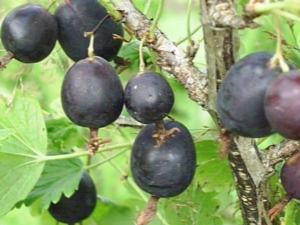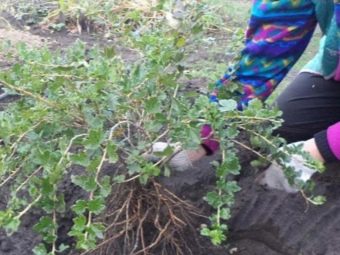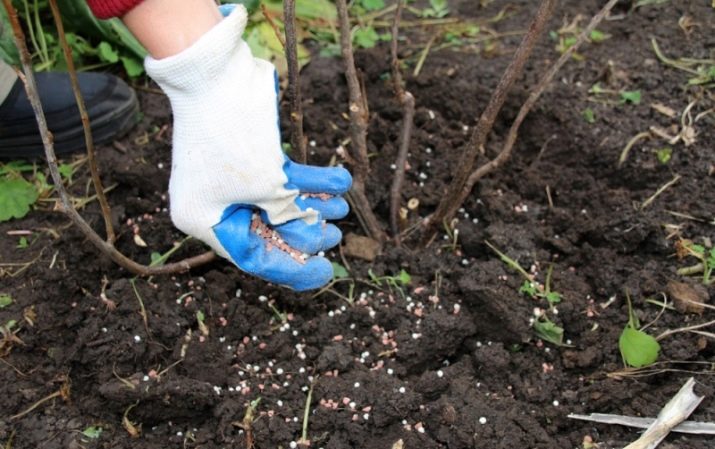Gooseberry "Phenic": characteristics and cultivation of the variety

When planting fruit bushes on his plot, any gardener wants them to bear fruit and not give much inconvenience. One of these plants is the gooseberry with the unusual name "Date".It is he who is often chosen by summer residents for unpretentiousness in care and good taste.
Plant description
"Phenicia" is a gooseberry that has strong, branchy shoots. With good care, the height of the bush reaches two meters. On each branch in a large number there are thorns, they are absent only at the very top. The color of the leaf blades is bright green, the leaves are smooth, without rough edges. In plants whose lifespan has more than one year, foliage may be slightly wrinkled.
As a rule, "Phenicia" gives large, fruit-rich fruit. Young bushes give berries weighing about twenty-five grams, older specimens bear berries of fifteen grams. The shape of the fruit resembles a pear, in rare cases - the ball. The fruit color is maroon-brown, with a barely noticeable wax coating. The flesh is green, the taste is more sour, although sugar is also present in the gooseberry.
Advantages and disadvantages
Growing gooseberries of this variety, gardeners have to face not only positive but also negative qualities of the variety. The advantages of "Date" include the following:
- excellent resistance to cold and hot temperatures;
- long life without compromising the quality of the fruit;
- good keeping quality and the ability to transport over long distances;
- stable fruiting;
- excellent taste of fruits, which can not only be eaten fresh, but also make of them all sorts of sauces, jams, preserves.
Among the shortcomings are the following:
- almost zero resistance to varietal diseases;
- the need for regular preventive measures;
- late fruiting (almost at the end of summer).
Landing details
Planted "Phenicia" can be both in spring and autumn. Autumnal planting is considered to be more favorable, since at minus temperatures the roots are remarkably formed. The fall planting dates begin on September 15th. Spring planting is rare, as the plant may not settle down.
However, if you choose this option, you need to catch the landing by mid-March, as soon as the top layer of snow comes down.
The first thing a gardener needs to do is decide on the site of the gooseberry planting. It should be said that this plant requires certain growing conditions. The site must be bright - Shaded areas will trigger the development of powdery mildew. And there should be no currant plantations nearby. Soil selection is an equally important step. The gooseberry practically does not grow on heavy or sour soil, therefore provide him light, oxygen-breathing loamy soil. If there is nothing to choose from, and all the land on the site is the same, be sure to pour it with lime before planting, so you can reduce the acidity.
It is best to choose a hot day for planting, since in the absence of the sun the bushes will root well. The preparation itself begins in a few weeks. First, thoroughly clean the area, ensuring that no last year’s weeds or roots remain. Next, make such dressings as:
- eight kilograms of manure;
- two kilograms of fertilizer with potassium;
- five kilograms of fertilizer containing phosphorus.
Pits are dug not too large, enough depth of 60 cm. It is very important that the distance between each bush is at least one and a half meters, and between the rows - two. Digging holes, you need to wait at least two weeks so that the inner layers of the soil adapt to external conditions. Seedlings, which were previously dipped in growth stimulants, begin to prepare for planting. To this end, the ground is poured into the pit one third, then the sprout itself is installed. The root system is well cracked and covered with earth.
The next step is watering at the rate of ten liters per bush. It will be necessary only to mulch the soil and leave the sapling in this condition for the whole winter.
Proper care
Before talking about all agrotechnical measures, it is worth noting the need to erect a support for the gooseberry. To do this, you need to drive into the ground four strong pipes, and on them to lay thin boards or wooden bars. Thus, the plant will be in an improvised "cage", which will help it not to lose clusters, breaking off under its own weight.
Watering
Despite the fact that "Phenicia" tolerates a dry summer well, it is necessary to supply water in the right amount. To determine if a plant needs liquid, try the ground. If it is slightly wet and well frayed, watering can not be carried out. If the soil is dry, lumpy, this means that drying begins. In a normal summer, not characterized by constant temperature changes, gooseberries are watered three times a month. Watering is associated with certain conditions: a special trench is made around the perimeter of the plants; its depth will be fifteen centimeters, then slowly pour about five buckets of water into it. Should remember you cannot damage the roots, so do not dig deeper than thirty centimeters from the root system.
Obligatory watering is also carried out in the period when new shoots grow, as well as when berries begin to form.
Weeding
Weeding is one of the most important stages of soil care. Thanks to it you can avoid the spread of weeds, which entails disease and pests. The first time the land is weeded, as soon as the snow melts, then the procedure is carried out on a regular basis after each water supply. In August, any loosening and weeding is stopped until the next season. Once finished weeding, you need to put mulch. For this purpose, well suited fresh grass, manure. For every hundred square meters of plantings you will need thirty kilograms of compost or the same amount of grass.
Fertilizers
The good news is that the first three years after planting a gardener does not need to take care of dressing. If you wish, you can fertilize plants a little with nitrogen, which will help them to grow greens faster. With the rest of the feeding should be postponed. When the fourth year comes, it is time to feed the gooseberries with minerals. Well suited mineral mixtures, which are diluted in accordance with the instructions on the packaging, as well as served as fertilizer superphosphate, ammonium nitrate. Before collecting the fruit, be sure to spend organic supplements.
It is necessary to take four parts of water and one part of bird droppings, additionally dissolve in a bucket of water, the resulting liquid is poured under each bush.
Pruning
Many gardeners do not spend enough time pruning, and in fact it is one of the important preventive measures. Thanks to pruning, the bushes get enough oxygen, minimizing the risk of catching a viral or fungal disease. The first pruning carried out in early spring, be sure to have time before flowering and the formation of buds. Remove all the old, frail shoots, leaving about six buds on the strongest. The top will also need to be removed. The next pruning is carried out at the end of summer or at the very beginning of autumn, with the shoots of last year shortened by one third.
If any diseased or sagging branches appear, they are immediately removed, regardless of the weather conditions or the season.
Reviews
Most gardeners are satisfied with the presence of such a gooseberry on their plot as “Date”. This is not surprising, because with proper care, he will regularly bear fruit, give tasty fruits. Observe simple agrotechnology, the need for rare irrigation, excellent taste of the fruit. Nevertheless, many gardeners stop what has to be done pruning, to avoid which no one will succeed, otherwise plantings will turn into impassable thicket. In addition, the gooseberry is weakly opposed to powdery mildew, which can also be a problem for large plantations.
How to care for gooseberries, see the following video.





























